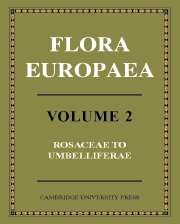 Flora Europaea vol 2 front cover | |
| Author | eds. T. G. Tutin, V. H. Heywood, N. A. Burges, D. H. Valentine, S. M. Walters, D. A. Webb |
|---|---|
| Publisher | Cambridge University Press |
Publication date | 6 December 2001 |
| Publication place | United Kingdom |
| Media type | Hardback (5 vols) + CD |
| Pages | 2392 |
| ISBN | 978-0-521-80570-4 |
The Flora Europaea is a 5-volume encyclopedia of plants, published between 1964 and 1993 by Cambridge University Press. The aim was to describe all the national Floras of Europe in a single, authoritative publication to help readers identify any wild or widely cultivated plant in Europe to the subspecies level. It also provides information on geographical distribution, habitat preference, and chromosome number, where known.
Contents
- History
- Volumes
- Volume 1 : Lycopodiaceae to Platanaceae
- Volume 2: Rosaceae to Umbelliferae
- Volume 3: Diapensiaceae to Myoporaceae
- Volume 4: Plantaginaceae to Compositae (and Rubiaceae)
- Volume 5: Alismataceae to Orchidaceae
- Volume 1 Revised: Psilotaceae to Platanaceae
- 5 Volume Set and CD-ROM Pack
- Editors
- Regional advisers
- See also
- Geographical Codes
- References
- External links
The Flora was released in CD form in 2001, and the Royal Botanic Garden Edinburgh have made an index to the plant names available online.